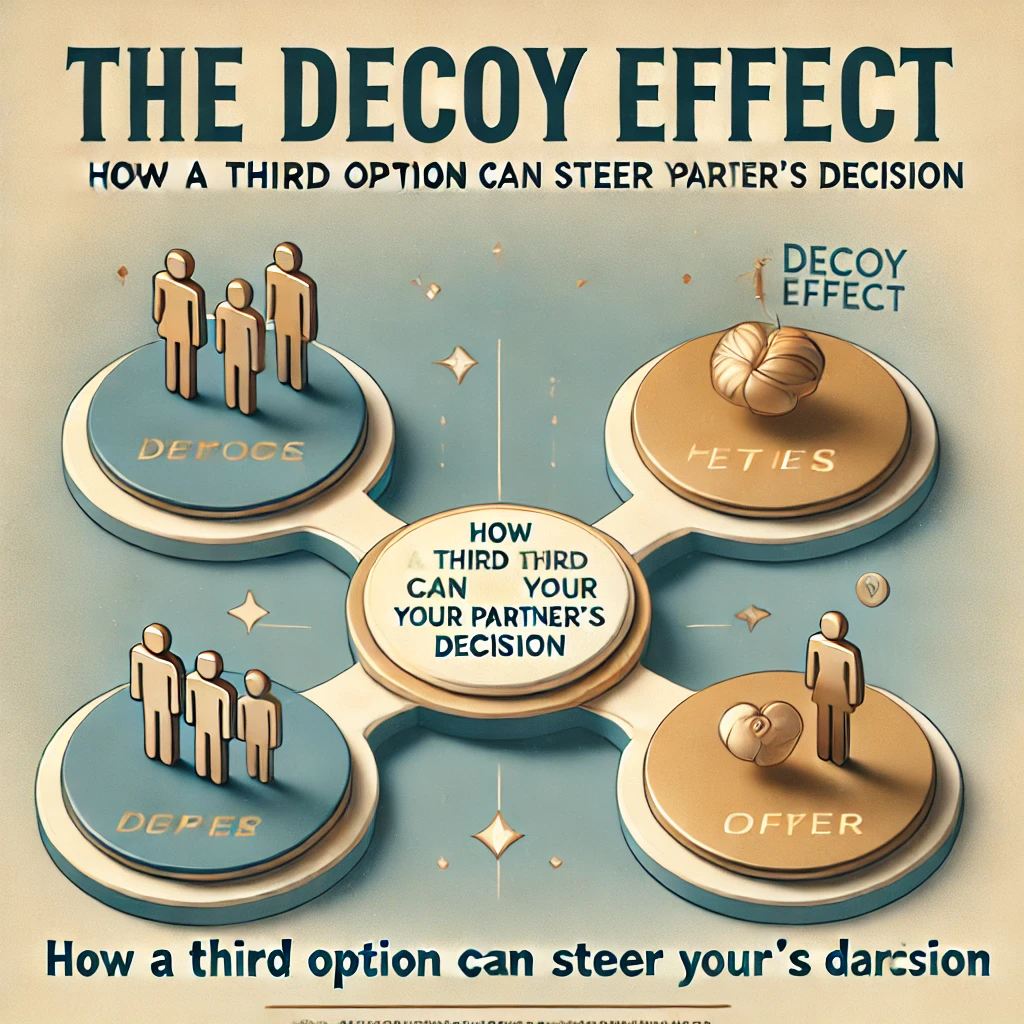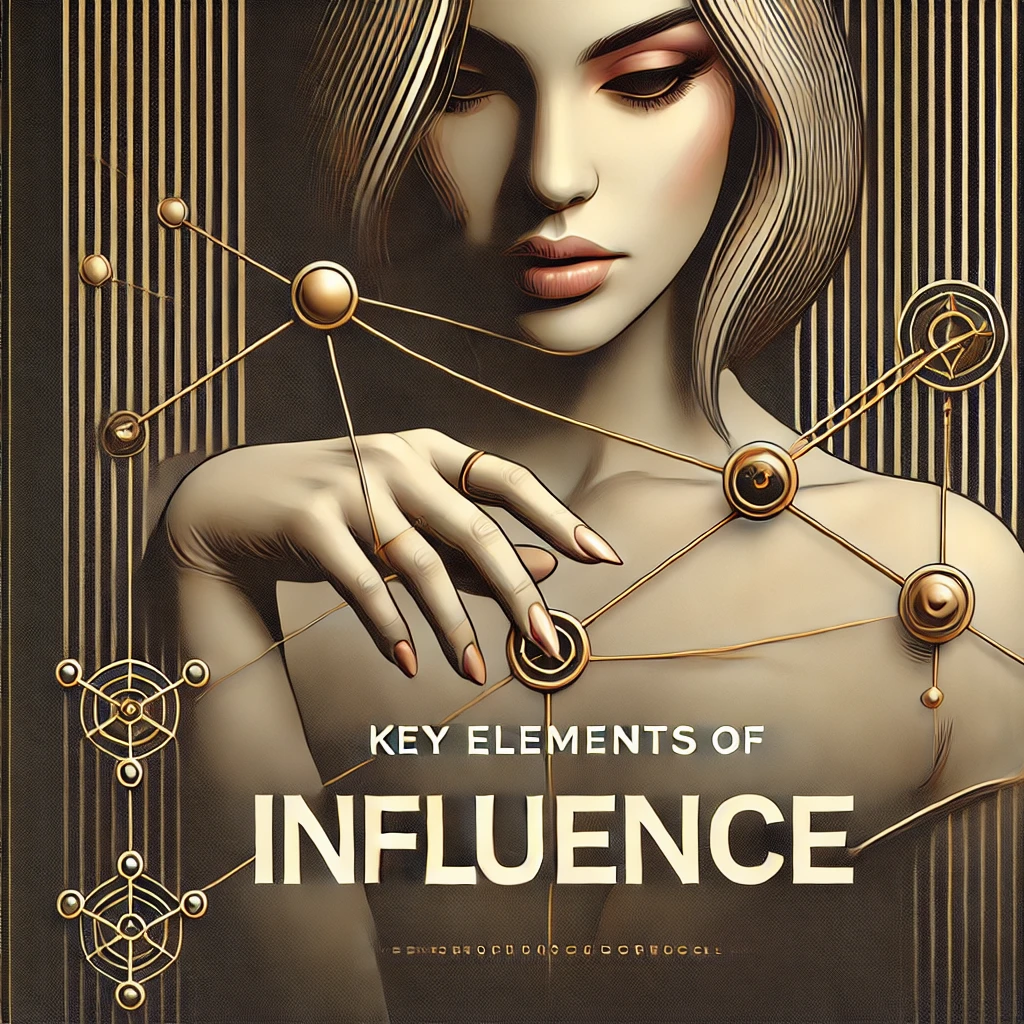Have you ever been torn between two options, only to have a third option suddenly make your decision clear? That’s the Decoy Effect at work—a psychological strategy used to influence decision-making by introducing a third option that steers people toward a particular choice. While this technique is often used in marketing, it can be just as powerful in relationships, helping you gently guide your partner’s decisions in a way that feels natural and collaborative.
The Decoy Effect happens when you present two main options and then introduce a third option that makes one of the original choices more attractive by comparison. The third option—the “decoy”—is strategically positioned to nudge the decision toward your desired outcome. In relationships, this can be useful when making decisions about anything from date night plans to bigger life choices like vacations or major purchases. The beauty of the Decoy Effect is that it doesn’t feel like manipulation; it feels like providing additional context that makes the decision-making process clearer and easier for your partner.
In this blog, we’ll dive into the Decoy Effect, explain how it works, and provide practical, relatable examples of how you can use it in your relationship to guide decisions without creating conflict. By the end, you’ll see how introducing a carefully crafted third option can help you and your partner make decisions that align with your goals.
What Is the Decoy Effect?
The Decoy Effect occurs when a third option is introduced into a decision-making process, making one of the original options look far more appealing by comparison. The decoy option is typically less attractive or less valuable but is designed to highlight the benefits of the option you really want. It plays on the human tendency to compare choices and seek the best value.
For example, let’s say you’re trying to decide between two vacation options: a budget-friendly beach resort or a luxurious but expensive five-star hotel. Introducing a third, overly expensive option (perhaps a weeklong stay at a remote island that’s way out of budget) can make the five-star hotel seem like the best deal by comparison, even though it still costs more than the beach resort. The decoy makes the middle option—the five-star hotel—look more appealing.
Why Does the Decoy Effect Work?
The Decoy Effect works because people tend to make decisions by comparing options. When faced with two choices, it can be hard to see which one is the “better” deal. But when a third option is introduced, especially one that’s clearly inferior or unbalanced, it makes one of the original choices look like the obvious winner. The brain naturally gravitates toward the option that feels like the best value, even if it wasn’t the original preference.
In relationships, this can be a great way to guide decision-making without pressuring your partner. The decoy option gives context to the choices and helps your partner feel more confident about their decision—because they feel like they’re making the choice, not being forced into it.
How to Use the Decoy Effect in Relationships
Let’s explore how the Decoy Effect can be applied to everyday scenarios in your relationship, helping you guide your partner’s decisions in a way that feels collaborative and thoughtful.
Example 1: Choosing a Restaurant for Date Night
You want to try a nice restaurant for date night, but your partner is more budget-conscious and may prefer a casual option. Instead of directly pushing for your preferred choice, you can use the Decoy Effect to make it more appealing.
How to Use the Decoy Effect:
Present three options for dinner:
- Option 1: A super-casual, inexpensive diner.
- Option 2: A nice, upscale restaurant that’s slightly above your usual budget (the one you prefer).
- Option 3: A very expensive, fine-dining restaurant that’s far beyond your usual budget (the decoy).
By presenting the high-end fine-dining option as a decoy, your preferred middle option suddenly looks like the perfect compromise—still special and upscale, but not overly extravagant.
Why It Works:
The high-end restaurant serves as a decoy, making the upscale restaurant feel like the best of both worlds. Your partner is more likely to agree because it feels like a balanced decision between budget and experience.
Example 2: Planning a Weekend Getaway
You’ve been dreaming of a romantic weekend getaway, but your partner might be hesitant to spend too much money or travel too far. By using the Decoy Effect, you can present options that highlight the appeal of your desired destination.
How to Use the Decoy Effect:
Offer three options for the getaway:
- Option 1: A budget-friendly but less exciting local spot.
- Option 2: A cozy, slightly more expensive weekend cabin in the mountains (your preferred option).
- Option 3: A luxury spa weekend in a faraway location that is much more expensive and requires more planning (the decoy).
With the luxury spa weekend acting as the decoy, your preferred option—the cozy cabin—feels like the perfect blend of affordability, fun, and relaxation.
Why It Works:
The decoy option, while tempting, feels impractical or over-the-top, making the cozy cabin seem like a sensible yet enjoyable choice. Your partner feels like they’ve chosen something special without breaking the bank.
Example 3: Deciding on Household Purchases
Let’s say you and your partner are discussing buying new furniture, but you have different ideas about how much to spend. You can use the Decoy Effect to nudge the decision toward a balanced choice that works for both of you.
How to Use the Decoy Effect:
Present three options for a new piece of furniture:
- Option 1: A cheap, low-quality option that you’re not thrilled about.
- Option 2: A stylish, high-quality piece that’s a little above your usual budget but will last a long time (your preferred choice).
- Option 3: An extremely expensive designer piece that’s beautiful but well out of your budget (the decoy).
By introducing the expensive designer piece as a decoy, the mid-range stylish option seems like a smart investment without feeling excessive.
Why It Works:
The decoy option highlights the value and practicality of the mid-range piece, making your preferred choice more appealing. Your partner feels like they’re getting something high-quality without overspending.
Example 4: Choosing a New Hobby or Activity
You want to take up a new hobby together, but your partner isn’t sure what to choose. Using the Decoy Effect can help steer the decision toward something you’ll both enjoy.
How to Use the Decoy Effect:
Present three options for new hobbies:
- Option 1: A simple, inexpensive hobby that you’re not very excited about.
- Option 2: A creative, slightly more expensive hobby like pottery or cooking classes (your preferred option).
- Option 3: A very expensive and time-consuming hobby like scuba diving or horseback riding (the decoy).
The expensive and time-consuming option serves as the decoy, making the creative hobby seem like the perfect mix of fun, affordability, and practicality.
Why It Works:
The decoy makes the creative hobby seem like the best of both worlds—engaging but not too costly or demanding. Your partner is more likely to go along with it because it feels like a well-balanced choice.
Example 5: Negotiating Time Together
You want to spend more quality time with your partner, but they have a busy schedule and might push back on committing to too much at once. By using the Decoy Effect, you can make your desired amount of time feel more reasonable.
How to Use the Decoy Effect:
Present three options for how much time to spend together:
- Option 1: A very brief check-in, like a quick coffee together (the bare minimum).
- Option 2: A full Saturday afternoon spent together doing something fun and relaxing (your preferred option).
- Option 3: A full weekend away, which might feel overwhelming given their busy schedule (the decoy).
The full weekend away acts as the decoy, making the Saturday afternoon option feel more manageable and appealing.
Why It Works:
The decoy option feels like too much, making the Saturday afternoon commitment seem like a fair and reasonable amount of time. Your partner is more likely to agree because it feels like a balanced choice that accommodates their schedule.
Why the Decoy Effect Works in Relationships
The Decoy Effect is powerful because it plays on human psychology and the natural desire to make decisions that feel balanced and reasonable. When you introduce a decoy option, it helps frame the other choices in a way that makes one of them clearly more appealing—without directly influencing or pressuring your partner.
In relationships, this is especially useful because it allows you to guide decision-making in a way that feels collaborative. Your partner feels like they’re making the best choice based on the options presented, but you’ve subtly steered the conversation toward the outcome you prefer.
Tips for Using the Decoy Effect in Your Relationship
Here are a few key tips for applying the Decoy Effect effectively in your relationship:
- Make the Decoy Realistic: The decoy option should be an exaggerated version of one of the other choices, but not so unrealistic that it feels like a joke. It needs to be something your partner could reasonably consider.
- Balance the Options: Ensure that all the options feel like legitimate choices. The Decoy Effect only works if the middle option—the one you prefer—feels like the perfect compromise between the two extremes.
- Be Subtle: The goal is to guide your partner without making them feel manipulated. Present the options naturally and let them come to their own conclusion, even if you’ve set up the choices in a way that nudges them in a particular direction.
- Use It Sparingly: The Decoy Effect is most effective when used occasionally. If you use it too often, your partner might catch on or feel like their choices are always being manipulated.
Q&A:
- What is the Decoy Effect, and how does it work in relationships?
The Decoy Effect is a decision-making tactic that introduces a third option to make a particular choice more appealing, subtly guiding choices without pressure. - How can I use the Decoy Effect to influence my partner’s decisions?
By presenting a third option that’s less desirable, you can make your preferred choice look like the best option, helping guide decisions on things like dates or purchases. - Why does the Decoy Effect work in everyday decisions?
It works because people tend to compare choices; the decoy option highlights the benefits of one choice over the other, making it feel like the best value. - Can the Decoy Effect help with budget-related decisions in relationships?
Yes, using a decoy option can make a slightly higher-cost option look more reasonable by comparison, making budget discussions easier and more agreeable. - What are examples of using the Decoy Effect in relationships?
Examples include choosing restaurants, vacation spots, or even weekend plans by introducing a third option that makes your preferred choice more attractive. - Is the Decoy Effect ethical to use with my partner?
When used responsibly to create fair compromises, it’s a subtle influence strategy; ethics come into play if it’s used to manipulate or deceive. - How do I introduce a decoy option without making it obvious?
Make the decoy a real option, just a bit exaggerated or impractical, and present it naturally so it doesn’t feel forced or manipulative. - Can the Decoy Effect help resolve conflicts in decision-making?
Yes, the decoy can make one choice feel like a better compromise, helping resolve conflicts without anyone feeling forced. - What are some practical ways to use the Decoy Effect for date night planning?
For date nights, offer a casual, a middle, and a high-end option, positioning your preferred choice in the middle to look like the best balance of fun and affordability. - How often should I use the Decoy Effect in my relationship?
Use it sparingly; if used too frequently, your partner may feel as if choices are manipulated. Occasional use keeps it effective and respectful.
Ready to Master the Art of Subtle Influence in Your Relationship?
If you’re ready to take your influence skills to the next level and learn how to guide your relationship decisions with ease, “Mastering Him: The Secret Art of Gentle Control in Relationships” is your ultimate guide. In Chapter 5, you’ll dive deeper into the Decoy Effect and explore 12 other powerful strategies to subtly influence your partner’s behavior, decisions, and emotions.
Get your copy today and start mastering the art of influence in your relationship. It’s time to create the outcomes you want by using subtle psychology to your advantage.
Read more about the book: https://developmentpill.com/mastering-him-the-secret-art-of-gentle-control-in-relationships-a-guide-to-influence-hell-never-see-coming/
Book Link: https://www.amazon.com/dp/B0DKKGLZQ9
Book Link UK: https://www.amazon.co.uk/dp/B0DKKGLZQ9
You can find book Links for other regions in this post page: https://developmentpill.com/mastering-him-the-secret-art-of-gentle-control-in-relationships-a-guide-to-influence-hell-never-see-coming/



